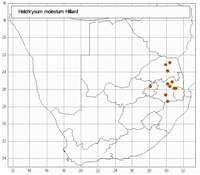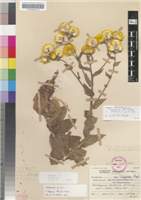Origin of name:
molestum = troublesome, burdensome, annoying, irksome
Diagnostic characters:
Bright yellow bractsLarge solitary headsBranched inflorescence
Description:
Perennial herb up to c. 1 m tall, stems several from the base, simple below, branching above into the compound inflorescence, stout, glandular-setose, uppermost parts sometimes cobwebby as well, closely leafy. Leaves mostly 65�100 x 18�32 mm, smaller on the inflorescence branches, oblong or oblong-ovate, uppermost ovate-lanceolate, apex acute, mucronate, base cordate-clasping, shortly decurrent, both surfaces glandular setose, margins and midline sometimes thinly white-woolly (sometimes one or both surfaces thinly woolly: see notes below). Heads heterogamous, depressed-globose, c. 11�14 mm long, 22�30 mm across the radiating bracts, many in a large leafy spreading corymbose panicle. Involucral bracts in c. 9 series, graded, imbricate, much exceeding the flowers, glossy, bright yellow. Receptacle shortly honeycombed. Flowers c. 1000�1300, 65�135 female, 1035�1235 homogamous. Pappus bristles many, equaling corolla, tips barbellate, shaft scabrid, bases cohering by patent cilia.
Flowering mainly in March and April.
Distribution:
Favours moist ground in rough grassland or at the margins of scrub or forest patches. Recorded with certainty from the highlands of Mpumalanga, from Mount Anderson south to the Barberton mountains, but possibly ranges as far north as the Soutpansberg, west along the Magaliesberg, and south to northern KwaZulu-Natal.
Grassland and Savanna Biomes.
Notes:
H. molestum can easily, be confused with H. difficile, but is usually more robust, with broader leaves; it is distinguished from H. cooperi by its perennial habit and usually larger heads.
The leaves of H. molestum are usually green below. However, Hilliard & Burtt 14207 (E; NU; PRE) is probably no more than a variant with leaves thinly white-woolly below; it grew in the vicinity of normal green-leaved plants. Hilliard & Burtt 14162 (E; K; NU; PRE; S) from Elandshoogte near Machadodorp has leaves thinly woolly on both surfaces. Hybrids are also known: see under H. albilanatum.
In the absence of basal parts or field notes it is impossible to place many specimens.
Plants from further south, in northern Natal, at Itala Nature Reserve near Louwsburg, and nearby Ngome Forest Reserve, differ from H. molestum in having a single very short main stem branching near the base, not several stems from the base; leaves may be wholly green, or lightly white-woolly below, or lightly woolly on both surfaces (Hilliard & Burtt 9934, E; NU; Hilliard & Burtt 10000, E; K; NU; S). Similar plants occur on Gorongoza Mountain in Mozambique, and two specimens from Swaziland, regrettably only parts of inflorescences, probably also belong here (Burtt Davy 2154, PRE, and Stewart in TM 9000, PRE). Clearly much field work is needed to sort out the species in this whole difficult group.
Taxonomy:
Literature:
Helichrysum molestum Hilliard in Notes R. bot. Gdn Edinb. 40: 260 (1982).
Type:
Mpumalanga, 2530 BA, Sabie to Lydenburg road, Long Tom Pass, Whisky Spruit, marshy ground by stream, 15 iii 1981, Hilliard & Burtt 14364 (NU, holo.; E; PRE, iso.).
Synonym(s):
Vouchers:
Hilliard & Burtt 14209 (E; K; NU; PRE); Kluge sub Hilliard & Burtt 14240 (E; K; NU; PRE); Taylor 1902 (PRE).

